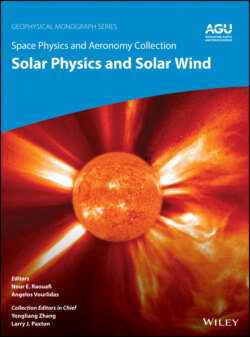Читать книгу Space Physics and Aeronomy, Solar Physics and Solar Wind - Группа авторов - Страница 27
1.6. THE EVOLUTION OF THE SOLAR WIND FROM THE INNER TO OUTER HELIOSPHERE
ОглавлениеThere are far fewer measurements of the solar wind in the outer heliosphere than in the inner heliosphere; however, measurements of the solar wind taken by the Pioneer 10/11 and Voyager 1/2 spacecraft showed that the heliosphere changes in two important ways. First, beyond 1 AU, solar wind interaction regions begin to dominate the heliosphere. Around 2–3 AU (Gosling et al., 1976; Hundhausen & Gosling, 1976; E. J. Smith & Wolfe, 1976), the dynamic compression of the slow wind by the fast wind creates a high‐pressure region that expands in the reference frame of the solar wind, producing a forward fast shock and a reverse shock. The expansion of the compression region into the fast stream continually removes plasma from the high‐speed stream to create larger, simpler structures. As the wind continues outward, the slower streams become more prominent, and the interaction regions broaden ahead of the fast wind.
At approximately 7 to 10 AU, by which time the fast and slow wind streams have given way to large interaction regions (Burlaga et al., 1995), successive interaction regions begin to interact themselves, forming “merged interaction regions.” On average, there exists a single merged interaction region per solar rotation near 10 AU (Hundhausen & Gosling, 1976). Around 20 AU, these merged interaction regions and their associated shocks are replaced by corotating pressure enhancements that slowly form large pressure rings concentric to the Sun (Whang & Burlaga, 1990). These have been called “global merged interaction regions” and, together with merged interaction regions, play a significant role in the modulation of galactic cosmic rays (Burlaga et al., 1993; Wang et al., 2006).
The second important difference in the solar wind of the outer heliosphere is the existence of a new population of ions called “pick‐up ions.” Beyond several tens of AUs, these pick‐up ions actually modify the properties of the solar wind and must be accounted for. A pick‐up ion is created when a neutral atom, streaming into the heliosphere from the local interstellar medium, becomes ionized (Vasyliunas & Siscoe, 1976; Isenberg, 1987). The ionization processes include charge exchange with solar wind ions, photoionization from solar photons, and impact ionization from solar wind electrons. Out of these, charge exchange is the dominant interaction process, whereby a singly charged ion passes close to the neutral atom and captures one of its electrons.
Once ionized, the new pick‐up ion starts to gyrate around the magnetic field. The ion starts with a very small velocity as compared with the solar wind flow (about 23 km/s). Therefore, the ion experiences a motional electric field caused by the moving solar wind plasma. The pick‐up ion gains energy from this electric field until its guiding center reaches a velocity that is equivalent to the solar wind flow velocity, at which point it becomes part of the bulk flow and is convected outward with the expanding solar wind. After the pick‐up, the ions experience gyrotropization and isotropization by either ambient or self‐generated, low‐frequency electromagnetic fluctuations in the solar wind plasma. In the spacecraft frame, this process appears as if those new ions are “picked up” by the solar wind flow.
We have not thoroughly grasped the transport of pick‐up ions in the solar wind due to the lack of measurements of keV‐ions in the outer heliosphere. The production of the suprathermal tails on the velocity distribution functions, in particular, remains a puzzle (Chalov et al., 2003; Fahr & Fichtner, 2011). It is believed that during their propagation through the outer heliosphere, pick‐up ions undergo pitch‐angle scattering and stochastic acceleration by interactions with different kinds of solar wind turbulences (Chalov et al., 1997). Pick‐up ions may also play a significant role in mediating the solar wind interaction with the interstellar medium, possibly changing the structure of the heliosheath through charge exchange (Zank, 1999), but more measurements are needed.
